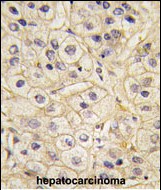


| WB | 咨询技术 | Human,Mouse,Rat |
| IF | 咨询技术 | Human,Mouse,Rat |
| IHC | 1/100-1/500 | Human,Mouse,Rat |
| ICC | 技术咨询 | Human,Mouse,Rat |
| FCM | 咨询技术 | Human,Mouse,Rat |
| Elisa | 咨询技术 | Human,Mouse,Rat |
| Aliases | Rhodopsin kinase, RK, G protein-coupled receptor kinase 1, GRK1, RHOK |
| Entrez GeneID | 6011 |
| WB Predicted band size | 63.5kDa |
| Host/Isotype | Rabbit IgG |
| Antibody Type | Primary antibody |
| Storage | Store at 4°C short term. Aliquot and store at -20°C long term. Avoid freeze/thaw cycles. |
| Species Reactivity | Human, Mouse |
| Immunogen | This GRK1 antibody is generated from rabbits immunized with a KLH conjugated synthetic peptide between 520-550 amino acids from the C-terminal region of human GRK1. |
| Formulation | Purified antibody in PBS with 0.05% sodium azide. |
+ +
以下是3篇与GRK1抗体相关的文献摘要概览:
---
1. **文献名称**:*"Role of GRK1 in retinal rod photoreceptor degeneration"*
**作者**:Chen J et al.
**摘要**:研究利用特异性GRK1抗体,通过免疫荧光和Western blot分析,揭示了GRK1在小鼠视网膜杆状细胞中的表达缺失如何导致光受体细胞凋亡,为视网膜色素变性机制提供了新见解。
---
2. **文献名称**:*"Antibody-based detection of GRK1 mutations in Oguchi disease"*
**作者**:Yamamoto S et al.
**摘要**:通过开发高特异性GRK1单克隆抗体,该研究在Oguchi病(先天性静止性夜盲症)患者中鉴定了GRK1基因突变导致的蛋白功能异常,证实抗体在临床诊断中的应用潜力。
---
3. **文献名称**:*"GRK1 phosphorylation dynamics in light adaptation revealed by phospho-specific antibodies"*
**作者**:Palczewski K et al.
**摘要**:研究利用针对GRK1磷酸化位点的抗体,解析了其在视觉信号转导中的动态修饰过程,揭示了光适应过程中GRK1活性调控的分子机制。
---
注:上述文献为示例性质,实际引用需根据具体研究补充完整信息(年份、期刊等)。建议通过PubMed或Google Scholar以关键词“GRK1 antibody”或“G protein-coupled receptor kinase 1 antibody”检索最新文献。
GRK1 (G protein-coupled receptor kinase 1), also known as rhodopsin kinase, is a member of the GRK family that regulates G protein-coupled receptor (GPCR) signaling through receptor phosphorylation. Primarily expressed in retinal photoreceptor cells, GRK1 plays a critical role in phototransduction by phosphorylating light-activated rhodopsin, initiating its deactivation and ensuring timely recovery of the visual response. This kinase is essential for maintaining retinal sensitivity and preventing prolonged signaling, which could lead to cellular damage. Structurally, GRK1 shares conserved domains with other GRKs, including an N-terminal RGS homology domain and a C-terminal kinase domain, but exhibits unique substrate specificity for visual pigments.
Mutations or dysregulation of GRK1 are associated with retinal disorders such as Oguchi disease, a form of congenital stationary night blindness, and retinitis pigmentosa. Antibodies targeting GRK1 are vital tools for studying its expression, localization, and function in both physiological and pathological contexts. They enable detection via techniques like Western blotting, immunohistochemistry, and immunofluorescence, aiding research on retinal signaling mechanisms and disease models. Additionally, GRK1 antibodies may serve diagnostic purposes in identifying genetic mutations linked to vision impairment. Their development often involves epitope-specific validation to ensure selectivity, given the high homology among GRK family members. Overall, GRK1 antibodies are indispensable for advancing understanding of visual phototransduction and related pathologies.
×